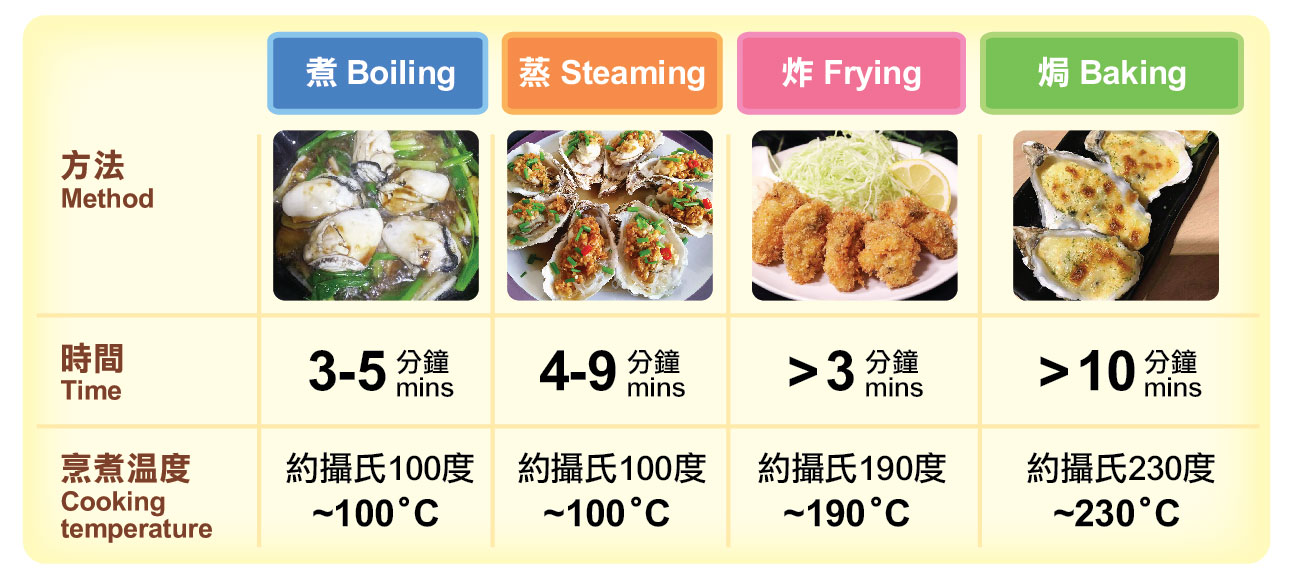
Food Safety Focus (197th Issue, December 2022)– Article 2
Oysters: Know the Microbiological Risk and Eat Safely
Reported by Ms. Melva CHEN, Scientific Officer,
Risk Communication Section, Centre for Food Safety
The Centre for Food Safety (CFS) investigated four food poisoning cases associated with the consumption of raw oysters in November 2022, with two cases involving a total of six people who dined at a restaurant, one case involving 10 people at another restaurant, and one case involving 23 people who attended a banquet. The affected persons had gastrointestinal symptoms such as abdominal pain, diarrhoea, nausea, and vomiting.
The CFS all along has been educating the public on the risks of eating raw oysters. However, raw oysters have gained increasing popularity among local people as reflected from our Food Consumption Survey. Meanwhile, there has recently been an increase in the number of local food poisoning cases related to raw oysters - over 100 cases in 2021, compared to an average of around 25 cases per year between 2016 and 2020. Consumers should be aware of the inherent food safety risks of raw oysters as raw oysters have not been heat-treated to kill harmful microorganisms.
Microbiological Risks of Oysters
Oysters are filter-feeders and concentrate microorganisms in sea-water. They are prone to be contaminated by harmful microorganisms such as Vibrio bacteria, norovirus and hepatitis A virus. Further, people can contract microorganisms with antimicrobial resistance (‘superbugs’) through eating raw or undercooked oysters. Whether or not ‘superbugs’ can cause illnesses, they may transfer their antimicrobial resistance genes to other bacteria inside the human body, therefore affecting the effectiveness of future use of antibiotics when needed.
To date, no technology exists that ensures that raw oysters are completely free of microbiological hazards. Imported raw oysters harvested in areas monitored for faecal contamination were occasionally found to be positive for norovirus by overseas authorities or linked to food poisoning outbreaks local and abroad. Although the majority of the affected persons have self-limiting diseases, consuming raw oysters can lead to serious health consequences, especially in vulnerable people like pregnant women, young children, the elderly, and people with weakened immunity.
To minimise the risk of food poisoning, it is best to cook oysters thoroughly reaching an internal temperature of 90°C for 90 seconds. Treating raw oysters with hot sauce, lemon juice, vinegar or alcohol does not kill the harmful microorganisms. The following figure are some tips on cooking oysters (Figure 3):

Figure 3: Tips for cooking oysters thoroughly
Reduce the Risks If Choosing to Eat Raw
Even though some people are aware that eating raw oysters can be risky, they still prefer to do so. In this case, these are certain measures that must be observed to reduce the microbiological risk.
Whether they eat out or at home, consumers should patronise reliable food premises with relevant endorsement or permits. Only eat those oysters that are meant for consuming raw. When purchasing live oysters in person, choose fresh and intact oysters. The shell should be shut or should close when tapped lightly. When ordering delivery, check the general condition of the oysters upon receipt, such as the temperature, the integrity of the container and the hygiene conditions. Before shucking, discard dead oysters and those with slimy surface, in dripping state or of dull colour.
To stay away from Temperature Danger Zone in which bacteria like Vibrio parahaemolyticus can grow and thrive rapidly, it is essential to keep the oysters cool at 4°C or below all the way before consumption. Oysters should be put on edible ice cubes to keep them cool, and eat them as soon as taken off from the shells
Food handlers should also prevent cross-contamination of foods during storage and handling of oysters by keeping oysters in a covered container in the refrigerator. Practise good hygiene at all times, including washing hands, using clean utensils, and washing and scrubbing the shells when handling the oysters. Always use clean, protective gloves and sterilised oyster shucking knives when shucking oysters to prevent injury and infection. Still, these measure are not fail-safe; without thorough cooking, the risk of infection from eating raw oysters cannot be eliminated.
To enhance food safety and allow consumers especially the susceptible individuals to make informed choices, the CFS has issued new food safety advice that provides the public with information on the food safety risks of raw oysters as well as a set of trade guidelines to assist the food businesses implementing appropriate and practical food safety measures when serving oysters to be eaten raw. Both the public and food businesses are urged to take the necessary precautions when eating or serving raw oysters.


